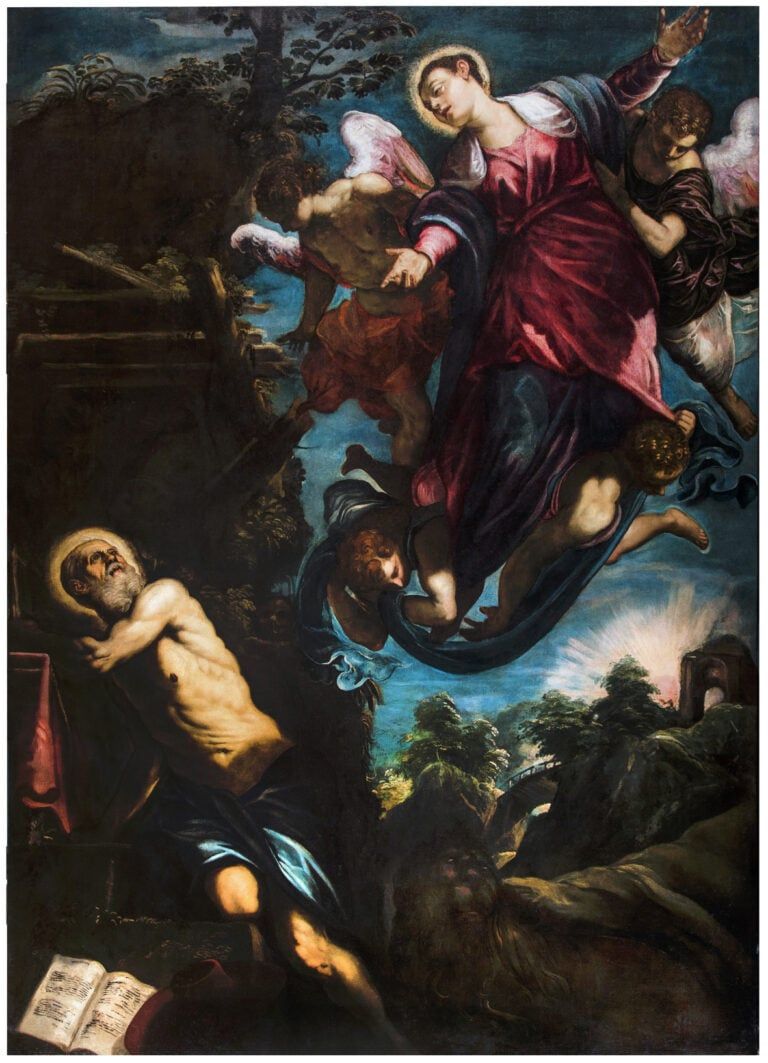Among the many events that dot Venice in 2024, the exhibition Lion of God by Walton Ford cannot be missed. It is hosted by the Venetian University of Sciences, Letters and Arts, an important place for the city of Venice not only for the beauty of the building that hosts it (the Scuola Grande di San Fantin, a stone’s throw from the Teatro La Fenice) but above all for its precious artistic collections. Precisely to a great work by Jacopo Tintoretto (The Apparition of the Virgin to Saint Jeromeca. 1580), which decorates the Library of the Veneto University, are inspired by the new paintings of the American Walton Ford (Larchmont, 1960), which therefore take on the quality of site-specific works in a concrete dialogue with the work of the Venetian master (exhibited exceptionally in the Sala Tommaseo for the entire duration of the exhibition). Neither the Virgin nor Saint Jerome are the protagonists of Lion of God: as the title suggests, it is the lion (an attribute that accompanies the saint in all his most famous depictions) that conquers the scene, following Ford’s attention to non-human animal entities. We talked about it with the curator of the exhibition Udo Kittelmann (Düsseldorf, 1958), former director of the Nationalgalerie in Berlin (which includes, among others, the Alte Nationalgalerie, the Hamburger Banhof, the Neue Nationalgalerie and the Museum Berggruen) from 2008 to 2020.
Interview with Udo Kittelmann
Let’s start with a ritual question. What does “cure” mean to you?
It means taking care of the artist’s imagination and desires, and helping him build an exhibition. And above all, be in a very deep dialogue with him or her. From the beginning of my career, when I started curating exhibitions, I understood that it is essential to deeply understand an artist’s practice in order to help him. You have to be the best critic of him, the most honest at least.
How did your collaboration with Walton Ford come about?
I think it was 2009 when I first encountered his work, and I was very impressed. I was immediately very attracted to his works: at first glance they seem very different from what you usually expect from contemporary art, but when you explore more deeply, let’s say, the problems that Walton addresses, they become extremely contemporary. Shortly after our first meeting, the following year in fact, I invited him to hold his first institutional exhibition in Europe, at the Hamburger Bahnhof in Berlin. At the time, I remember, I was very criticized for this: why bring this type of work to a contemporary art museum like that? Yet, at the end of the exhibition, we recorded an attendance of 140,000 visitors, even though Walton was not yet as well known as he is today. This taught me a lesson: much of the general public, who are not generally familiar with the latest discourses or theories of contemporary art, are repelled by it.
Indeed, the first thing I noticed was that Ford’s works seem to speak an ancient language. Perhaps this allows them to communicate the demands of the contemporary even to those who are not accustomed to the codes of today’s art?
Exactly, and their language is also very spiritual and somewhat emotional. Somehow they tune into the audience’s heartbeat.
The spirituality you speak of brings me to the next question: Walton Ford’s works are profoundly connected to the space we are in, the Ateneo Veneto, and to its collections. I am reminded of the many cases in which altarpieces were taken from the churches and cathedrals in which they were designed and then decontextualized within museums. How will this Walton Ford series survive once the exhibition is finished and when it is exhibited in other contexts?
The series of paintings Lion of God it is strongly conceived for the Veneto University and to enter into dialogue (and confront) with the Apparition of the Virgin to Saint Jerome by Tintoretto. When these works are separated from this context, they will continue to have their own independent life and impact. Certainly, however, seeing them in this exhibition is the best opportunity to grasp their profound links with Tintoretto’s great work, the environments of the Veneto University and Venice itself, given that the lion is the symbol par excellence of the city.
The article continues below
1 / 9
 2 / 9
2 / 9
 3 / 9
3 / 9
 4 / 9
4 / 9
 5 / 9
5 / 9
 6 / 9
6 / 9
 7 / 9
7 / 9
 8 / 9
8 / 9
 9 / 9
9 / 9
How can we overcome the temporal distance between Tintoretto and Walton Ford?
It is not important how many centuries have passed: art always tells the same story. It tries every time (to quote Paul Klee) to make the invisible visible, it deals with the human being as a spirit, it concerns emotions, love, hate, sense of guilt. But these are all things that are found throughout the history of humanity and do not change: it is people who change, and this makes them read the same history in new ways, contemporary to them.
I found it interesting the way in which Ford subverts an auxiliary character such as the lion in the story of Saint Jerome, making him the true protagonist of the works. Is Ford trying to tell us that we need to rethink our place in the world?
Certainly. Generally, Walton’s works attempt to remind us of our arrogance and that, as natural creatures, we should put an end to the cruelty that characterizes us. I would like to quote Spinoza, who said: “The idea of the ocean is always contained in a drop of water. We must take care of the drop of water to take care of the ocean”.
The only interaction between the human and the lion in Walton Ford’s works portrays the moment of extracting the thorns from the lion’s paw…
There is a representation of the relationship between species based on mutual help, on harmony, on love. This can also be seen a lot in the painting which represents the lion embracing the donkey: looking at it you can clearly perceive the closeness between the two animals.
And in this perhaps lies the political nature of Walton Ford’s works.
Walton’s work is very political: in his works, however, he does not place himself in the position of someone who shows what is right and what is wrong, political discourse does not appear in a didactic way. His political caliber emerges organically from his works, and that’s something that doesn’t happen in a lot of contemporary art today, which wants to push the viewer to think politically. The harmony between the donkey and the lion, despite their differences, leads us to reflect on our own nature: why can’t we coexist peacefully?
Alberto Villa
Artribune is also on Whatsapp. Simply click here to subscribe to the channel and always be updated















